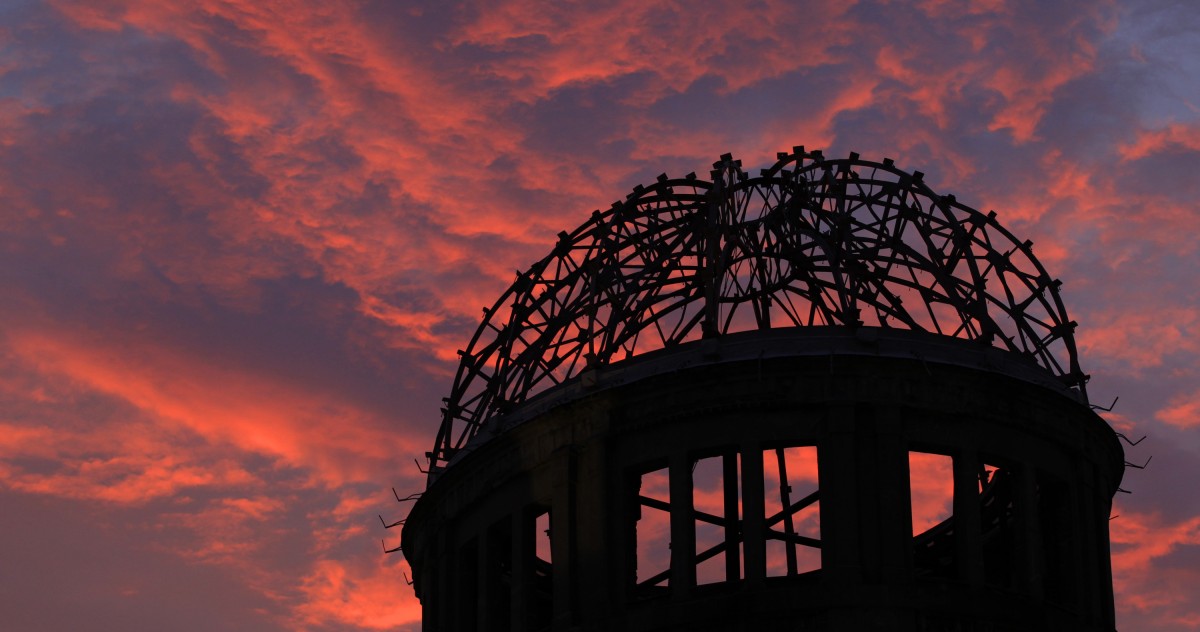 The Atomic Bomb Dome is silhouetted at sunset in Hiroshima, western Japan, Monday, Aug. 5, 2013. (Photo: Shizuo Kambayashi/AP)
The Atomic Bomb Dome is silhouetted at sunset in Hiroshima, western Japan, Monday, Aug. 5, 2013. (Photo: Shizuo Kambayashi/AP)
NEW YORK — Seventy years ago this coming August, Dr. Michihiko Hachiya was sprawled out on his living room floor in Hiroshima at about 8:15 in the morning. He was exhausted, he wrote, because he had stayed up all night on-duty at the hospital.
Attired in undergarments and gazing blankly through wide-open doors out into a sunny summer day, he described in his diary, “Suddenly, a strong flash of light startled me – and then another.”
He had just witnessed “Little Boy,” the codename given to the atomic bomb that was dropped on Dr. Hachiya’s city on Aug. 6, 1945. The August attacks claimed the lives of almost 250,000 people.
Twenty-five years later, in the spring of 1970, the Nuclear Non-Proliferation Treaty (NPT), which aims to stop the spread of nuclear weapons and promote the peaceful use of nuclear energy, was put into effect.
Later this month, from April 27 to May 22, the United Nations will hold a conference in New York to review the operation of the NPT. The aim of the conference is to strengthen the treaty by assessing how it has been implemented and to issue recommendations based on those findings. Held every five years, the last conference was held in 2010.
With 191 states as parties to the treaty, it’s the most recognized treaty in history. It identifies China, France, Russia, the United Kingdom and the United States as nuclear weapons states.
India, Israel, Pakistan and South Sudan have not signed the treaty, although they are U.N. member states. Palestine is the most recent state to have acceded to the treaty, having done so on Feb. 10 of this year.
The U.N. states that 2015’s conference will consider:
“[The] universality of the Treaty; nuclear disarmament, including specific practical measures; nuclear non-proliferation, including the promoting and strengthening of safeguards; measures to advance the peaceful use of nuclear energy, safety and security; regional disarmament and non-proliferation; implementation of the 1995 resolution on the Middle East; measures to address withdrawal from the Treaty; measures to further strengthen the review process; and ways to promote engagement with civil society in strengthening NPT norms and in promoting disarmament education.”
Biking for peace
A number of groups around the country have organized events to coincide with the U.N.’s review and to oppose nuclear weapons.
One such group, Footprints for Peace, a non-profit that organizes events to create solidarity around spiritual, cultural and environmental issues, has coordinated a walking, running and cycling event to promote a nuclear-free future and reflect on the horrors of the past.
The event, “Moving Toward a Nuclear Free Future 2015,” started on March 30 and will continue until April 25, two days before the U.N. review. Participants started in Oak Ridge, Tennessee, on March 30. Oak Ridge is where the atomic bomb that destroyed Hiroshima, Japan, on Aug. 6, 1945 was developed.
The Footprints for Peace website says participants visit the site to do a “vigil.” Travelers also go to Three-Mile Island, the site of the largest nuclear disaster in the U.S., and end at the U.N. building in New York two days before the commencement of the conference.
The walk/bike/run snakes up through Appalachia, via Tennessee, Virginia, D.C., Maryland, Pennsylvania, New Jersey, and into New York.
Voice from the bombing: Dr. Michihiko Hachiya
While many people died instantaneously after the atomic bombs dropped on Hiroshima, many people actually lived through them in tremendous pain.
Dr. Hachiya, who was the director of the Hiroshima Communications Hospital, wrote in his diary that he was confused about the origin of the flashes of light he had seen from his living room.
“So well does one recall little things that I remember vividly how a stone lantern in the garden became brilliantly lit and I debated whether this light was caused by a magnesium flare or sparks from a passing trolley.
Garden shadows disappeared. The view where a moment before had been so bright and sunny was now dark and hazy. Through swirling dust I could barely discern a wooden column that had supported one corner of my house. It was leaning crazily and the roof sagged dangerously.
…
A profound weakness overcame me, so I stopped to regain my strength. To my surprise I discovered that I was completely naked. How odd! Where were my drawers and undershirt?
What had happened?”
All over the right side of my body I was cut and bleeding. A large splinter was protruding from a mangled wound in my thigh, and something warm trickled into my mouth. My cheek was torn, I discovered as I felt it gingerly, with the lower lip laid wide open. Embedded in my neck was a sizable fragment of glass which I matter-of-factly dislodged, and with the detachment of one stunned and shocked I studied it and my blood-stained hand.”
His diary was published in English in 1955, but it’s certainly not the only surviving record of the bombings. Hiroshima and Nagasaki both have museums, artifacts and monuments to honor and remember the victims of the events.
The Hiroshima Peace Memorial Museum, for example, houses a collection of artwork created by bombing survivors, including a number of drawings created from memory. Many pieces are drawn in colored pencil on manila paper, and they’re remarkably similar to one another.
They feature naked bleeding bodies wandering around a city engulfed in fire comparable to the atomic bomb scene in the movie Terminator 2.

